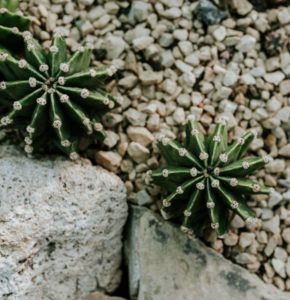Q: Are there any special measures that I need to take to keep my houseplants healthy through the winter?
A: To keep your houseplants happy all winter long, you need to address the four major challenges that they face:
(1) Fluctuating temperatures
(2) Reduced daylight
(3) Dry air
(4) Overwatering
These are definitely not ideal growing conditions and can cause stress to your plant companions!
1. Fluctuating temperatures throughout the day.
Most houseplants thrive in day temperatures between 65 and 75 degrees and nighttime temperatures above 50 degrees. Temperature fluctuations that fall outside of these ranges can come from ovens, radiators, or exterior doors – just to name a few! Moving plants away from sources of heat and cold will reduce their risk to dehydration and stress, keeping them healthy all winter. You may need to rearrange furniture or change plant stands/hangers to ensure stable temperatures which your plants will appreciate!
2. Shorter days with reduced daylight.
Wintertime brings shorter days and provides up to 50% less light to your indoor plants. Distance from the window plays a key role in light levels, so keep your plants within two feet of the window to guarantee that they receive enough light. Remember to close the curtains at night to keep the plant insulated from low overnight temperatures. Dust on windows and plant leaves can also inhibit light penetration. Make sure to clean the windows and wash plant leaves to maximize light absorption.
3. Dry Air or Lack of Humidity.

Most houseplants are tropical and need more humidity than most homes provide. People often mist the leaves, but that doesn’t provide adequate, steady humidity. The easiest way to deliver even humidity is with a pebble tray – a tray with a layer of small stones and filled with enough water to reach the tops of the stones. Place potted plants close together atop the stones, being careful the water doesn’t touch the pot. Check water daily and refill as needed.
4. Overwatering.
In general, houseplants need less water in the winter months than in the summer. Due to many of the factors discussed above, plants tend to slow their growth rate or even go dormant during the cold months. A good way to find out if your plant needs water is to check the moisture levels in the soil’s subsurface. Here’s how: stick your finger about two inches below the soil surface; if it’s dry, then it’s time to break out the watering can. If it’s still moist, then hold off on watering to avoid root rot and other diseases.
Additional Resources:
- Tips on Caring for Houseplants in the Winter
- Winter Care for Houseplants
- How to Determine the Proper Light Levels for Plants
 Contributed by Jean Lovell, long-time Resource Central volunteer and former master gardener, who helped answer your gardening questions. Although Miss Jean has retired from her volunteer role, we (Garden In A Box experts and low-water landscape enthusiasts) are here to help answer your questions.
Contributed by Jean Lovell, long-time Resource Central volunteer and former master gardener, who helped answer your gardening questions. Although Miss Jean has retired from her volunteer role, we (Garden In A Box experts and low-water landscape enthusiasts) are here to help answer your questions.
Please don’t hesitate to reach out to us at: GardenInfo@ResourceCentral.org or (303) 999-3820 x222.













